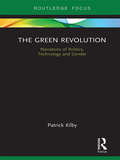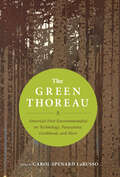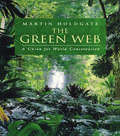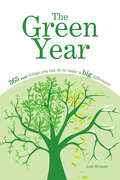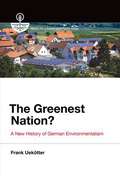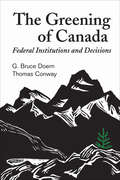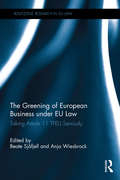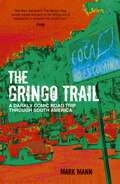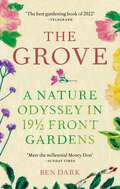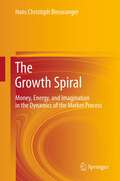- Table View
- List View
The Green Revolution: Narratives of Politics, Technology and Gender (Earthscan Food and Agriculture)
by Patrick KilbyThis book reviews the Green Revolution, starting with its inception and development from the 1940s to the 1970s, and leading to what is commonly referred to as a second Green Revolution in the 2000s. Building on the historical assessment, it draws insights for contemporary policy debates and demonstrates important lessons for the here and now. ‘Green Revolution’ refers to the technical measures employed to increase food (particularly grain) production, based mainly on improved seed varieties for higher yields and pest resistance. For it to be successful the Green Revolution often required land reform, investments in irrigation and fertilizer supply that were not available to women and marginal farmers. This book analyses three underlying principles that have guided green revolutions: the political environment in which they were set; how they contributed to both the successes and challenges the Green Revolution continues to face; and the systemic institutional barriers for access to these agricultural production advances, with a focus on how gender relations limit the inclusion of women even when they are the principle cultivators and farm managers. The book draws on experiences in Mexico, India and China, examining government policy, the role of the family farm, and key issues around the inclusion of women. In doing so, this book connects the history of the Green Revolution with contemporary policy debates on the developing world, particularly in relation to Africa and Asia, around foreign aid and agricultural research. It also specifically establishes that greater inclusivity for women and other marginalised farming communities will significantly enhance the effectiveness of these programs. Interlinking themes of development policy, gender, and agricultural research, this book will be of great interest to students and scholars of agricultural development, food security, and sustainable development, as well as policymakers and practitioners working in international aid and agri-food policies.
The Green Revolution: The American Environmental Movement (1962-1992)
by Eric Foner Kirkpatrick SaleThe Hill and Wang Critical Issues Series: concise, affordable works on pivotal topics in American history, society, and politics. The Green Revolution documents the tremendous change in public awareness and attitudes since the publication of Rachel Carson'sSilent Spring. Sale assesses the growth of national environmental organizations and the influence of scientists and their theories about global warming, the greenhouse effect, acid rain, toxic waste, and biodiversity. And he shows how environmental concerns affect all levels of society and much of our government's legislative and regulatory work.
The Green State in Africa
by Carl DeathA provocative reassessment of the relationship between states and environmental politics in Africa From climate-related risks such as crop failure and famine to longer-term concerns about sustainable urbanization, environmental justice, and biodiversity conservation, African states face a range of environmental issues. As Carl Death demonstrates, the ways in which they are addressing them have important political ramifications, and challenge current understandings of green politics. Death draws on almost a decade of research to reveal how central African environmental politics are to the transformation of African states.
The Green State: Rethinking Democracy and Sovereignty
by Robyn EckersleyWhat would constitute a definitively "green" state? In this important new book, Robyn Eckersley explores what it might take to create a green democratic state as an alternative to the classical liberal democratic state, the indiscriminate growth-dependent welfare state, and the neoliberal market-focused state—seeking, she writes, "to navigate between undisciplined political imagination and pessimistic resignation to the status quo." In recent years, most environmental scholars and environmentalists have characterized the sovereign state as ineffectual and have criticized nations for perpetuating ecological destruction. Going consciously against the grain of much current thinking, this book argues that the state is still the preeminent political institution for addressing environmental problems. States remain the gatekeepers of the global order, and greening the state is a necessary step, Eckersley argues, toward greening domestic and international policy and law.The Green State seeks to connect the moral and practical concerns of the environmental movement with contemporary theories about the state, democracy, and justice. Eckersley's proposed "critical political ecology" expands the boundaries of the moral community to include the natural environment in which the human community is embedded. This is the first book to make the vision of a "good" green state explicit, to explore the obstacles to its achievement, and to suggest practical constitutional and multilateral arrangements that could help transform the liberal democratic state into a postliberal green democratic state. Rethinking the state in light of the principles of ecological democracy ultimately casts it in a new role: that of an ecological steward and facilitator of transboundary democracy rather than a selfish actor jealously protecting its territory.
The Green Thoreau: America's First Environmentalist on Technology, Possessions, Livelihood, and More
by Henry David ThoreauHenry David Thoreau saw nature as teacher and companion, and many of his philosophies guide the contemporary environmental movement. What Thoreau wrote about simplicity, materialism, technology, and our troubled relationship with nature is perhaps even more relevant to our lives today than it was in the nineteenth century. In these pages, editor Carol Spenard LaRusso presents quotations by Thoreau on nature, technology, livelihood, living, possessions, time, diet and food, and aspiration. At turns passionate, funny, and profound, this collection serves as a compelling introduction — or vivid reminder — of why Thoreau is one of America’s iconoclastic greats.
The Green Web: A Union for World Conservation
by Martin HoldgateThis text is a history of the world's oldest global conservation body - the World Conservation Union, established in 1948 as a forum for governments, non-governmental organizations and individual conservationists. The author draws on unpublished archives to reveal the often turbulent story of the IUCN and its achievements in, and influence on, conservation and environmental policy worldwide - establishing national parks and protected areas and defending threatened species.
The Green Witch's Herb and Plant Encyclopedia: 150 Ingredients for Everyday Witchcraft
by Rowan MorganaEverything you need to know about using plants and herbs for green witchcraftInfusing your craft with plants and herbs is a powerful way to connect to Mother Earth. This green witchcraft encyclopedia explores the most essential magical plants, offering you a complete resource for safely growing, foraging, harvesting, and using everything from aloe to valerian. Discover greater harmony with nature as you harness the natural energy of plants to create healing and balance in your life.150 plant profiles — Find detailed entries for the plants and herbs green witches use the most, including photos, explanations of each plant's magical properties, and tips for how to grow them yourself.Herb magic in action — Experience the power of plant magic with spells and rituals to try, such as banishing negativity with catnip and clover or building a fairy altar with foxglove and thyme.Embrace your inner witch — Part reference guide and part grimoire, this book of herbs helps you develop your practice by exploring how to set intentions, create a sacred space, and maintain your own garden.Start your own witch's apothecary and create some everyday magic with this encyclopedia of magical herbs and plants.
The Green Year: 365 Small Things You Can Do to Make a Big Difference
by Jodi HelmerGo green one day at a time. Do something every day. Most of us want to do the right thing for the environment, but making the commitment to change our fast-paced, convenience-oriented lifestyles can be more than a little daunting. What&’s the answer? Take that giant commitment and cut it up into 365 little commitments that get met one day at a time. The Green Year does just that. More than a calendar, it offers simple, practical, affordable, and engaging activities that make going green a blessing rather than a burden. In addition to these easy green suggestions, readers will find in The Green Year: • The &“why&” behind each activity—what makes it good for the environment and the reader? • A quick &“how-to&” for any activity that requires it • Room for readers to write in their own creative alternatives • Helpful illustrations
The Greenest Nation?
by Frank UekötterGermany enjoys an enviably green reputation. Environmentalists in other countries applaud its strict environmental laws, its world-class green technology firms, its phase-out of nuclear power, and its influential Green Party. Germans are proud of these achievements, and environmentalism has become part of the German national identity. In The Greenest Nation? Frank Uekötter offers an overview of the evolution of German environmentalism since the late nineteenth century. He discusses, among other things, early efforts at nature protection and urban sanitation, the Nazi experience, and civic mobilization in the postwar years. He shows that much of Germany's green reputation rests on accomplishments of the 1980s, and emphasizes the mutually supportive roles of environmental nongovernmental organizations, corporations, and the state. Uekötter looks at environmentalism in terms of civic activism, government policy, and culture and life, eschewing the usual focus on politics, prophets, and NGOs. He also views German environmentalism in an international context, tracing transnational networks of environmental issues and actions and discussing German achievements in relation to global trends. Bringing his discussion up to the present, he shows the influence of the past on today's environmental decisions. As environmentalism is wrestling with the challenges of the twenty-first century, Germany could provide a laboratory for the rest of the world.
The Greenest Nation?: A New History of German Environmentalism (History for a Sustainable Future)
by Frank UekotterAn account of German environmentalism that shows the influence of the past on today's environmental decisions.Germany enjoys an enviably green reputation. Environmentalists in other countries applaud its strict environmental laws, its world-class green technology firms, its phase-out of nuclear power, and its influential Green Party. Germans are proud of these achievements, and environmentalism has become part of the German national identity. In The Greenest Nation? Frank Uekötter offers an overview of the evolution of German environmentalism since the late nineteenth century. He discusses, among other things, early efforts at nature protection and urban sanitation, the Nazi experience, and civic mobilization in the postwar years. He shows that much of Germany's green reputation rests on accomplishments of the 1980s, and emphasizes the mutually supportive roles of environmental nongovernmental organizations, corporations, and the state.Uekötter looks at environmentalism in terms of civic activism, government policy, and culture and life, eschewing the usual focus on politics, prophets, and NGOs. He also views German environmentalism in an international context, tracing transnational networks of environmental issues and actions and discussing German achievements in relation to global trends. Bringing his discussion up to the present, he shows the influence of the past on today's environmental decisions. As environmentalism is wrestling with the challenges of the twenty-first century, Germany could provide a laboratory for the rest of the world.
The Greenhouse Effect (A True Book (Relaunch))
by Mara GrunbaumWhat controls Earth's temperature? How do the changes happening now compare to those that have happened in the past? This book lays out how the makeup of Earth's atmosphere can affect everything living beneath it, and how human activities - from cutting down trees to burning fossil fuels - are changing the climate worldwide.Glaciers are melting. Summers are heating up. Sea levels are on the rise. Climate change is affecting every corner of our planet - and it's the subject of a lot of concern, activism, and debate. STEM meets current events in this new A True Book set that offers readers the chance to learn about the causes and effects of climate change, as well as how people around the world are reacting to it. Students will read about the history and scope of the problem, analyze the same kinds of evidence that scientists do, and come away with tools that will help them respond to this pressing global issue.This series covers Next Generation Science Standards core ideas including Weather and Climate, Human Impacts on Earth Systems, Conservation of Energy and Energy Transfer, and Biodiversity and Humans.
The Greening of Asia: The Business Case for Solving Asia's Environmental Emergency (Columbia Business School Publishing Ser.)
by Mark CliffordOne of Asia's best-respected writers on business and economy, Hong Kong-based author Mark L. Clifford provides a behind-the-scenes look at what companies in China, India, Japan, Korea, the Philippines, Indonesia, Hong Kong, Singapore, and Thailand are doing to build businesses that will lessen the environmental impact of Asia's extraordinary economic growth. Dirty air, foul water, and hellishly overcrowded cities are threatening to choke the region's impressive prosperity. Recognizing a business opportunity in solving social problems, Asian businesses have developed innovative responses to the region's environmental crises. From solar and wind power technologies to green buildings, electric cars, water services, and sustainable tropical forestry, Asian corporations are upending old business models in their home countries and throughout the world. Companies have the money, the technology, and the people to act—yet, as Clifford emphasizes, support from the government (in the form of more effective, market-friendly policies) and the engagement of civil society are crucial for a region-wide shift to greener business practices. Clifford paints detailed profiles of what some of these companies are doing and includes a unique appendix that encapsulates the environmental business practices of more than fifty companies mentioned in the book.
The Greening of Canada: Federal Institutions and Decisions
by G. Bruce Doern Thomas ConwayEnvironmental matters have become increasingly important in Canadian and world policy agendas. In this study, G. Bruce Doern and Thomas Conway trace the development of Canadian environment policy, giving an in-depth account of twenty years of environmental politics, politicians, institutions, and decisions as seen through the evolution of Ottawa's policy agency, Environment Canada. The Greening of Canada is an extensively researched look at the entire period from the early 1970s to the present and is the most complete and integrated analysis yet of federal environmental institutions and key decisions. From Great Lakes pollution to the Green Plan, from the Stockholm Conference to the post–Rio Earth Summit era, the authors deal with both domestic and international events and influences on Ottawa's often abortive efforts to entrench a green agenda into national politics. The book explores the crucial relationships of institutional and political power, directing attention at the DOE and its parade of ministers, intra-cabinet battles, federal-provincial relations, business relations and public opinion, and international and Canada–U.S. relations. It also examines important topics from acid-rain policy to the politics of establishing national parks, and from the Green Plan to the realities of environmental enforcement. Employing a framework cast as the 'double dynamic' of environmental policy making, the authors show the growing struggle between the management of power among key institutions and the need to accommodate a biophysical realm characterized by increased uncertainty as well as scientific and technological controversy.
The Greening of European Business under EU Law: Taking Article 11 TFEU Seriously (Routledge Research in EU Law)
by Beate Sjåfjell Anja WiesbrockThe relationship between environmentally sustainable development and company and business law has emerged in recent years as a matter of major concern for many scholars, policy-makers, businesses and nongovernmental organisations. This book offers a conceptual analysis of the principles of sustainable development and environmental integration in the EU legal system. It particularly focuses on Article 11 of the Treaty on the Functioning of the European Union (TFEU), which states that EU activities must integrate environmental protection requirements and emphasise the promotion of sustainable development. The book gives an overview of the role played by the environmental integration principle in EU law, both at the level of European legislation and at the level of Member State practice. Contributors to the volume identify and analyse the main legal issues related to the importance of Article 11 TFEU in various policy areas of EU law affecting European businesses, such as company law, insurance and state aid. In drawing together these strands the book sets out the requirements of environmental integration and examines its impact on the regulation of business in the EU. The book will be of great use and interest to students and researchers of business law, environment law, and EU law.
The Greening of US Free Trade Agreements: From NAFTA to the Present Day (Routledge Focus on Environment and Sustainability)
by Linda AllenThis book provides an up-to-date critical analysis of the integration of environmental policies into US free trade agreements. The work focuses on the evolution of the design of environmental policies and analyzes their effectiveness. Starting with the North American Free Trade Agreement (NAFTA) leading to the Trans-Pacific Partnership (TPP), the book examines the history of policy integration. In doing so, it provides an overview of the major trade-related environmental policies and presents empirical research on their effectiveness, a discussion of the continued demand for policy integration in light of the effectiveness, and recommendations for addressing shortcomings. The main objective of the book is to inform the ongoing policy debate over integration of environmental policies into trade agreements. The current renegotiation of NAFTA provides an opportune time for undertaking this critical review of trade-related environmental policies. As our understanding and knowledge of the environmental policies associated with US trade agreements, in particular for NAFTA, has grown significantly over the past twenty-five years, this book provides a timely and critical update for this policy debate. Students and scholars of environmental law, trade and economics, and specifically US trade, environmental policy and law will find this book of great interest.
The Greenpeace to Amchitka
by Robert Keziere Robert HunterGreenpeace is known around the world for its activism and education surrounding environmental and biodiversity issues. With a presence in more than 40 countries across Europe, the Americas, Asia and the Pacific, Greenpeace is undoubtedly a dominant force in the realm of environmental activism.This is the story of how Greenpeace came to be.In September 1971, a small group of activists boarded a small fishing boat in Vancouver, Canada, and headed north towards Amchitka, a tiny island west of Alaska in the Aleutian Islands, where the US government was conducting underground nuclear tests.At that time, protests against nuclear testing were not common, yet the US tests raised genuine concerns: Amchitka is not only the last refuge for endangered wildlife, but is also located in a geologically unstable region, one of the most earthquake-prone areas in the world. The threat of a nuclear-triggered earthquake or tsunami was real.Among the people sardined in the fishing boat were Robert Hunter and Robert Keziere.The boat, named the Greenpeace by the small group of men aboard, raced against time as it crashed through the Gulf of Alaska, braving the oncoming winter storms. Three weeks was all they had to reach Amchitka in an attempt to halt the nuclear test. Ultimately, the voyage--beset by bad weather, interpersonal tensions and conflicts with US officials--was doomed. And yet the legacy of that journey lives on.In this visceral memoir, based on a manuscript originally written over 30 years ago, Robert Hunter vividly depicts the peculiar odyssey that led to the formation of the most powerful environmental organization in the world.Features 40 black and white photographs taken during the voyage by Robert Keziere.
The Gringo Trail: A Darkly Comic Road Trip through South America
by Mark MannMark Mann and his girlfriend Melissa set off to explore the ancient monuments, mountains and rainforests of South America. But for their friend Mark, South America meant only one thing: drugs. Sad, funny and shocking, The Gringo Trail is a darkly comic road-trip and a revealing journey through South America’s turbulent history.
The Grizzly Mother (Mothers of Xsan)
by Hetxw’ms Gyetxw HusonBook two in the award-winning Mothers of Xsan series, The Grizzly Mother uses striking illustration and lyrical language to bring the poetry of the Xsan ecosystem to life.To the Gitxsan people of Northwestern British Columbia, the grizzly is an integral part of the natural landscape. Together, they share the land and forests that the Skeena River runs through, as well as the sockeye salmon within it. Follow mother bear as she teaches her cubs what they need to survive on their own.
The Grizzly Mother (Mothers of Xsan)
by Hetxw’ms Gyetxw HusonBook two in the award-winning Mothers of Xsan series, The Grizzly Mother uses striking illustration and lyrical language to bring the poetry of the Xsan ecosystem to life.To the Gitxsan people of Northwestern British Columbia, the grizzly is an integral part of the natural landscape. Together, they share the land and forests that the Skeena River runs through, as well as the sockeye salmon within it. Follow mother bear as she teaches her cubs what they need to survive on their own.
The Grooming of Alice (Alice McKinley #12)
by Phyllis Reynolds NaylorDuring the summer between eighth and ninth grades. Alice and her friends Pamela and Elizabeth decide to improve themselves through exercise.
The Ground Beneath Us: From the Oldest Cities to the Last Wilderness, What Dirt Tells Us About Who We Are
by Paul BogardOur most compelling resource just might be the ground beneath our feet. When a teaspoon of soil contains millions of species, and when we pave over the earth on a daily basis, what does that mean for our future? What is the risk to our food supply, the planet's wildlife, the soil on which every life-form depends? How much undeveloped, untrodden ground do we even have left?Paul Bogard set out to answer these questions in The Ground Beneath Us, and what he discovered is astounding.From New York (where more than 118,000,000 tons of human development rest on top of Manhattan Island) to Mexico City (which sinks inches each year into the Aztec ruins beneath it), Bogard shows us the weight of our cities' footprints. And as we see hallowed ground coughing up bullets at a Civil War battlefield; long-hidden remains emerging from below the sites of concentration camps; the dangerous, alluring power of fracking; the fragility of the giant redwoods, our planet's oldest living things; the surprises hidden under a Major League ballpark's grass; and the sublime beauty of our few remaining wildest places, one truth becomes blazingly clear: The ground is the easiest resource to forget, and the last we should.Bogard's The Ground Beneath Us is deeply transporting reading that introduces farmers, geologists, ecologists, cartographers, and others in a quest to understand the importance of something too many of us take for granted: dirt. From growth and life to death and loss, and from the subsurface technologies that run our cities to the dwindling number of idyllic Edens that remain, this is the fascinating story of the ground beneath our feet.
The Groundhog Day Book of Facts and Fun
by Wendie C. OldThis book of facts and fun provides plenty of information about groundhogs and the origin of Groundhog Day. Groundhog riddles and ideas for throwing a Groundhog Day party are included.
The Grove: A Nature Odyssey in 19 ½ Front Gardens
by Ben Dark***'Ben Dark is such a wonderful writer - The Grove drew me in from the first line.' Lia Leendertz'The Grove is overflowing with delicious nuggets of cultural, social and garden history - and I adore Ben Dark's humour and humility in equal measure.' Advolly Richmond'A heartfelt romp through the wisteria and wilderness of London's horticulturally remarkable front gardens.' Jack Wallington'Fans of Ben Dark's mellifluous tones on The Garden Log podcast will be delighted by how perfectly his lyrical musings transfer to the printed page as, with infant son in tow, he invites the reader upon a series of horticultural expeditions inspired by the deceptively ordinary planting of the front gardens in a south London street. The kind of thoroughly enjoyable read where you realise, late in the day, that learning has snuck in by the back door, though you feel inclined to forgive the author on account of the fun you've had along the way.'Andrew O'Brien'Any walk is an odyssey when we connect with the plants around us. Each tree or flower tells a tale. Mundane 'suburban' shrubs speak of war and poetry, of money, fashion, love and failure. Every species in this book was seen from one pavement over twelve months and there is little here that could not be found on any road in any town, but they reveal stories of such weirdness, drama, passion and humour that, once discovered, familiar neighbourhoods will be changed forever.' Ben DarkThere is a renewed interest in the nature on our doorsteps, as can be seen in the work of amateur botanists identifying wildflowers and chalking the names on the pavements.But beyond the garden wall lies a wealth of cultivated plants, each with a unique tale to tell. In The Grove, award-winning writer and head gardener Ben Dark reveals the remarkable secrets of twenty commonly found species - including the rose, wisteria, buddleja, box and the tulip - encountered in the front gardens of one London street over the course of year. As Ben writes, in those small front gardens 'are stories of ambition, envy, hope and failure' and The Grove is about so much more than a single street, or indeed the plants found in its 19 ½ front gardens. It's a beguiling blend of horticultural history and personal narrative and a lyrical exploration of why gardens and gardening matter.
The Grove: A Nature Odyssey in 19 ½ Front Gardens
by Ben Dark***'Ben Dark is such a wonderful writer - The Grove drew me in from the first line.' Lia Leendertz'The Grove is overflowing with delicious nuggets of cultural, social and garden history - and I adore Ben Dark's humour and humility in equal measure.' Advolly Richmond'A heartfelt romp through the wisteria and wilderness of London's horticulturally remarkable front gardens.' Jack Wallington'Fans of Ben Dark's mellifluous tones on The Garden Log podcast will be delighted by how perfectly his lyrical musings transfer to the printed page as, with infant son in tow, he invites the reader upon a series of horticultural expeditions inspired by the deceptively ordinary planting of the front gardens in a south London street. The kind of thoroughly enjoyable read where you realise, late in the day, that learning has snuck in by the back door, though you feel inclined to forgive the author on account of the fun you've had along the way.'Andrew O'Brien'Any walk is an odyssey when we connect with the plants around us. Each tree or flower tells a tale. Mundane 'suburban' shrubs speak of war and poetry, of money, fashion, love and failure. Every species in this book was seen from one pavement over twelve months and there is little here that could not be found on any road in any town, but they reveal stories of such weirdness, drama, passion and humour that, once discovered, familiar neighbourhoods will be changed forever.' Ben DarkThere is a renewed interest in the nature on our doorsteps, as can be seen in the work of amateur botanists identifying wildflowers and chalking the names on the pavements.But beyond the garden wall lies a wealth of cultivated plants, each with a unique tale to tell. In The Grove, award-winning writer and head gardener Ben Dark reveals the remarkable secrets of twenty commonly found species - including the rose, wisteria, buddleja, box and the tulip - encountered in the front gardens of one London street over the course of year. As Ben writes, in those small front gardens 'are stories of ambition, envy, hope and failure' and The Grove is about so much more than a single street, or indeed the plants found in its 19 ½ front gardens. It's a beguiling blend of horticultural history and personal narrative and a lyrical exploration of why gardens and gardening matter.
The Growth Spiral: Money, Energy, and Imagination in the Dynamics of the Market Process
by Hans Christoph BinswangerThis book develops a new theory of the modern economy. Conventional economic theory is (still) based on an essentially static notion of equilibrium. In contrast, this book offers an analysis of the economic process based on a truly dynamic approach. It understands modern economic activity as manifesting itself in a growth spiral. There are two main drivers of the dynamics of this spiral: steady money creation in the banking system, on the one hand; and the continuous inflow of energy and raw materials through the exploitation of natural resources, on the other. Both driving forces are generally neglected by the conventional theory. Understanding their role is absolutely essential for preventing our economy from being more and more exposed to financial and ecological crises. This book offers important insights about the functioning of the modern economy and addresses the specialist as well as the interested lay reader.
